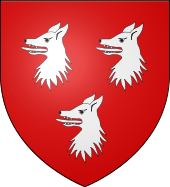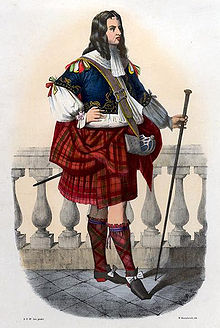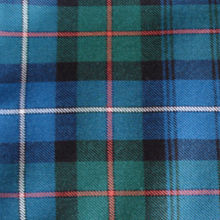- Clan Donnachaidh
-
Clan Donnachaidh / Clan Robertson Crest badge 
Crest: A dexter hand holding up an imperial crown Proper Motto: Virtutis gloria merces War cry: Garg 'nuair dhùisgear (Fierce when roused) Profile Plant badge bracken or fern Pipe music Teachd Chlann Dhonnchaidh (Coming of the Robertsons)[1] Gaelic name MacDhonnchaidh, Robasdan Chief

Alexander Robertson of Struan The 24th Chief of Clan Donnachaidh Septs of Clan Donnachaidh / Clan Robertson Collier[2], Colyear[2], Conlow
Connachie[2], Dobbie
Dobieson[2], Dobinson[2], Dobson
Donachie[2], Donica, Donnachie[2], Duncan[2], Duncanson[2], Dunkeson[3], Dunnachie[2], Inches[2], MacConachie[2], MacConlogue, MacConnichie[2], MacDonachie[2], MacInroy[2], MacIver[2], MacIvor[2], MacLagan[2], MacLaggan[2], MacRob[2], MacRobb[2], MacRobbie[2], MacRobert[2], MacRobie[2], MacWilliam[2], Reed[2], Reid[2], Robb[2], Roberts[2], Robison[2], Robson[2], Roy[2], Stark[2], Tannoch[2], Tannochy[2]
Note that several of the above are merely anglicised variants of the Scottish Gaelic MacDhonnchaidh or literal translations into English of the same (Duncan, Duncanson, etc).Clan branches Robertson of Auchleeks.[4]
Robertson of Faskally.[4]
Robertson of Inches.[4]
Robertson of Kindeace.[4]
Robertson of Kinlochmouidart.[4]
Robertson of Lude.[4]
Robertson of Struan.[4]Allied clans Clan MacGregor Rival clans Clan Ogilvy Clan Donnachaidh (Scottish Gaelic: Clann Dhonnchaidh), also known as Clan Robertson, is one of the oldest of all Scottish clans.
Contents
History
Origins
There are two main theories as to the origins of the Clan Donnachaidh:
- That the founder of the clan, Donn(a)chadh (Duncan) was the second son of Angus MacDonald, Lord of the Isles.[5]
- That the Robertsons are lineal descendants of the Celtic Earls of Atholl, whose progenitor was King Duncan I (Donnchadh in Scottish Gaelic), eldest son of Malcolm II.[6]
Wars of Scottish Independence
The clan's first recognised chief, Donnchadh Reamhar, 'Stout Duncan', son of Andrew de Atholia (Latin 'Andrew of Atholl'), was a minor land-owner and leader of a kin-group around Dunkeld [7], Highland Perthshire, and as legend has it, an enthusiastic and faithful supporter of Robert I (king 1306–29) during the Wars of Scottish Independence; he is believed to have looked after King Robert after the Battle of Methven in 1306[citation needed]. The clan asserts that Stout Duncan's relatives and followers (not yet known as Robertsons) supported Robert the Bruce at the Battle of Bannockburn in 1314[8] (although this patriotic story is not supported by contemporary documentation). His descendants became known (in English or Scots) as the Duncansons, or Gaelic Clann Dhònnchaidh, 'Children of Duncan'.[4]
 "Robertson". A romanticised Victorian depiction of a member of the clan in a late 17th century dress by R. R. McIan, from The Clans of the Scottish Highlands, published in 1845.
"Robertson". A romanticised Victorian depiction of a member of the clan in a late 17th century dress by R. R. McIan, from The Clans of the Scottish Highlands, published in 1845.
14th and 15th century clan conflicts
In 1394 a clan battle took place between Clann Dhonnchaidh and Clan Ogilvy, during a cattle raid on Angus. Sir Walter Ogilvy was slain at this battle. Clandonoquhy had rather a reputation as raiders and feuders in late medieval Scotland, though the chiefs seem always to have been loyal to the Bruce and Stewart royal dynasties.[4]
Robert Riabhach ('Grizzled') Duncanson, 4th Chief of Clann Dhonnchaidh, was a strong supporter of King James I (1406–1437) and was incensed by his murder at the Blackfriars Dominican Friary in Perth. He tracked down and captured two of the regicides, Sir Robert Graham and the King's uncle Walter Stewart, Earl of Atholl, as they hid above Invervack in Atholl, and turned them over to the Crown. They were tortured to death in the Grassmarket in Edinburgh on the orders of the Regent, James I's widow, Joan Beaufort (d. 1445). The Robertson crest badge of a right hand upholding an imperial crown was awarded by James II (1437–60) to the 4th chief on 15 August 1451 as a reward for capturing his father's assassins. The highly unusual third supporter (below the shield) on the Robertson coat of arms, of a 'savage man in chains' is in reference to the capture of Graham. It is in honor of Robert Riabhach that his descendants took the name Robertson. James II also erected the clan lands into the Barony of Struan, which formerly took in extensive lands in Highland Perthshire, notably in Glen Errochty, the north and south banks of Loch Tay and the area surrounding Loch Rannoch. None of these lands are any longer in the possession of the clan.[4]
Struan (Gaelic Sruthan, 'stream'), is a parish church, of early Christian origin and dedicated to St. Fillan, at the confluence of the Errochty Water and Garry rivers. Many of the medieval chiefs were buried in this church (although individual monuments have unfortunately not survived). The present building was built in the early 19th century, but the foundations of its predecessor can be traced in the churchyard. Donnchadh Reamhar is, however, said to have been buried in the parish church of Dull, near Aberfeldy. Recent excavations by members of the Clan Donnachaidh Society within the now redundant church of Dull (Gaelic Dul, 'meadow', 'haugh') failed to find evidence of this specific burial, although others were uncovered, along with early medieval carved stones. Recent generations of chiefs have been buried in a family vault in the grounds of the estate of Dunalastair, near Kinloch Rannoch.[4]
17th century and Civil War
 Detail of a Clan Robertson kilt. Cf.[9]
Detail of a Clan Robertson kilt. Cf.[9]
Under Alexander Robertson, 12th chief, the clan are said to have supported James Graham, 1st Marquess of Montrose in all of his battles during the Scottish Civil War.[4] During this time, the main Robertson castle at Invervack, near the present Clan museum, was burned by Cromwell’s forces, and many family records were lost.
In 1653 the Earl of Glencairn was in Rannoch looking for support for Charles II. He raised the Clan MacGregor from the Isle of Rannoch and Alexander Robertson led his men from Fea Corrie. Both forces met above Annat and marched up the old path to Loch Garry. However, the leaders reportedly quarrelled so much among themselves that Cromwell's General, George Monk had little difficulty in winning the ensuing Battle of Dalnaspidal.[10]
Alexander Robertson, 13th chief (b. 1668) joined the Jacobite rising of 1689 and was taken prisoner a few weeks after the Jacobite defeat at the Battle of Dunkeld. After being released he went to live in France for thirteen years where he served for some time in the French army. He returned to Scotland in 1703.[4]
18th century and Jacobite uprisings
Hunting Ancient tartan. Cf.[11]
Alexander Robertson, 13th chief, led 500 men of Clan Donnachaidh in support of the Earl of Mar at the Battle of Sheriffmuir in 1715. He was captured, but later rescued and he took refuge in France.[4] The fighting force of Clan Robertson was estimated at 800 men in 1715 and at 700 men in 1745.[12]
After the defeat of the 1745/46 rebellion the Robertson lands became part of the Forfeited Estates, although most were returned to the then chief, another Alexander Robertson, in 1784, after it became clear that the Central Highlands were wholly pacified.[4]
Unlike many other Highland noblemen, the Robertson chiefs refused to 'clear' their estates of their clansmen in favour of the more profitable sheep during the late 18th and early 19th centuries. This honourable but financially disadvantageous policy led to the eventual alienation of the entire clan lands by the early 20th century. Only the family vault at Dunalastair is still in the possession of the family of Struan; however, many modern properties have been added to the clan land. The title Baron of Struan is still transferred through Dunalastair.[4]
Gaelic names
- MacDhonnchaidh (surname, 'son of Duncan')
- MacRaibeirt (surname, 'son of Robert')
- Robasdan (surname – used when following a first name)
- An Robasdanach (surname, 'the Robertson' – used on its own, without a first name)
- Clann MhicDhonnchaidh / Clann 'IcDhonnchaidh (collective – 'Clan Robertson')
- Clann Dhonnchaidh (collective)
- Na Robasdanaich (collective)
Note: the Gaelic spelling often appears with an "a" after the double nn of Dhonnchaidh, but this is not correct (though it does reflect the Gaelic insertion of an obscure vowel in pronunciation). Cf. the anglicised surname MacConnochie (and variants). "MacDhonnchaidh" and derivatives are usually used on the mainland, "Robasdan" and derivatives on the islands.[14]
Clan profile
- Motto: Virtutis gloria merces (Glory is the reward of valour)[15]
- Slogan: Garg 'nuair dhùisgear. (Fierce when roused)[12]
- Crest: A dexter hand holding up an imperial crown, all proper.[16]
- Badge: Bracken.[17] (the clan had lands on the southern side of Loch Rannoch – Gaelic Loch Raineach, 'Loch of Bracken'[18])
- Pipe music:
-
- Salute: Fàilte Thighearna Sruthain (Struan Robertson's Salute[1] or Laird of Struan's Salute[19]
- Gathering: Thàinig Clann Dhonnchaidh (The Robertsons Have Come)[1]
- March: Till an Crodh Dhonnchaidh (Turn the Cattle, Donnachaidh); Riobain Gorm (Blue Ribbon); Teachd Chlann Dhonnchaidh (Coming of the Robertsons)[1]
- Lament: Cumha Sruthain (Lament for Robertson of Struan)[1]
- Clan chief: Alexander Gilbert Haldane Robertson of Struan, 24th Chief of Clan Donnachaidh, 28th of Struan (styled Struan Robertson).[20]
See also
Notes and references
- ^ a b c d e Frank Adam, Thomas Innes: The Clans, Septs and Regiments of the Scottish Highlands 1934, p 423
- ^ a b c d e f g h i j k l m n o p q r s t u v w x y z aa ab ac ad ae af ag ah ai "The Official Clan Donnachaidh Web Site". http://www.donnachaidh.com/. Retrieved 20 September 2007.
- ^ "The Origin of The Duncanson Name". http://www.duncanson.org/info/name.htm. Retrieved 29 July 2009.
- ^ a b c d e f g h i j k l m n o p ” Chiefs of Clan Donnachaidh, 1275 – 1749 and the Highlanders at Bannockburn". By James Robertson. Printed by Wood and Son, Mill Street, Perth. 1929.
- ^ "Chiefs of Clan Donnachaidh, 1275 – 1749 and Highlanders at Bannockburn". By James Robertson. Quoting: Simbert, page 77. Printed by Wood and Son, Mill Street, Perth. 1929.
- ^ "Chiefs of Clan Donnachaidh, 1275 – 1749 and Highlanders at Bannockburn". By James Robertson. Quoting: William Forbes Skene, vol. 11. page 140. Printed by Wood and Son, Mill Street, Perth. 1929.
- ^ Moncreiffe, Iain (Sir Iain Moncreiffe of that Ilk). The Robertsons (Clan Donnachaidh of Atholl). Pub: W. & A.K. Johnston & G.W. Bacon Ltd., Edinburgh. 1962 (reprint of 1954), p6.
- ^ Ronald McNair Scott: Robert the Bruce, King of Scots, Hutchinson & Co 1982, p 243
- ^ Moncreiffe, Iain (Sir Iain Moncreiffe of that Ilk). The Robertsons (Clan Donnachaidh of Atholl). W. & A.K. Johnston & G.W. Bacon Ltd., Edinburgh. 1962 (reprint of 1954), p8(fig. opposite; cutline reads "Robertson Tartan").
- ^ "www.visitdunkeld.com". http://www.visitdunkeld.com/clan-robertson-rannoch.htm.
- ^ Moncreiffe, Iain (Sir Iain Moncreiffe of that Ilk). The Robertsons (Clan Donnachaidh of Atholl). W. & A.K. Johnston & G.W. Bacon Ltd., Edinburgh. 1962 (reprint of 1954), p9(fig. opposite; cutline reads "Robertson Hunting Tartan. Probably evolved 1803 for the Loyal Clan Donachie Volunteers (White Stripe added to Atholl Tartan").
- ^ a b "A Short History of the Clan Robertson". By Maj. J Robertson Reid. Printed at the Observer Press, Stirling, Scotland. 1933.
- ^ This 1842 publication was rife with errors and outright hoaxes.
- ^ Iain Mac an Tàilleir: Ainmean pearsanta (available on SMO website)
- ^ Sir Bernard Burke: The general armory of England, Scotland, Ireland, and Wales, p 861
- ^ Alexander Deuchar: British Crests, p 241
- ^ Fox-Davies Charles: Heraldic Badges, p 139
- ^ Sabhal Mòr Ostaig
- ^ Moncreiffe, Iain (Sir Iain Moncreiffe of that Ilk). The Robertsons (Clan Donnachaidh of Atholl). W. & A.K. Johnston & G.W. Bacon Ltd., Edinburgh. 1962 (reprint of 1954), p27
- ^ Burke's Peerage and Gentry
External links
- www.donnachaidh.com – the Official Clan Donnachaidh Web Site
- www.robertson.org – Clan Donnachaidh Society
Scottish clans Clans with chiefs Agnew · Anstruther · Arbuthnott · Arthur · Bannerman · Barclay · Borthwick · Boyd · Boyle · Brodie · Broun · Bruce · Buchan · Burnett · Cameron · Campbell · Carmichael · Carnegie · Cathcart · Charteris · Chattan · Chisholm · Cochrane · Colquhoun · Colville · Cranstoun · Crichton · Cumming · Darroch · Davidson · Dewar · Drummond · Dunbar · Dundas · Durie · Elliot · Elphinstone · Erskine · Farquharson · Fergusson · Forbes · Forsyth · Fraser · Fraser of Lovat · Gayre · Gordon · Graham · Grant · Gregor · Grierson · Guthrie · Haig · Haldane · Hamilton · Hannay · Hay · Henderson · Home · Hope · Hunter · Irvine · Jardine · Johnstone · Keith · Kennedy · Kerr · Kincaid · Lamont · Leask · Lennox · Leslie · Lindsay · Lockhart · Lumsden · Lyon · MacAlister · MacBain · MacDonald · Macdonald of Clanranald · MacDonald of Keppoch · Macdonald of Sleat · MacDonell of Glengarry · MacDougall · Macdowall · MacIntyre · Mackay · Mackenzie · Mackinnon · Mackintosh · Maclachlan · Maclaine of Lochbuie · MacLaren · MacLea (Livingstone) · Maclean · MacLennan · MacLeod · MacLeod of Lewis · MacMillan · Macnab · Macnaghten · MacNeacail · MacNeil · Macpherson · MacTavish · MacThomas · Maitland · Makgill · Malcolm (MacCallum) · Mar · Marjoribanks · Matheson · Menzies · Moffat · Moncreiffe · Montgomery · Morrison · Munro · Murray · Napier · Nesbitt · Nicolson · Ogilvy · Oliphant · Primrose · Ramsay · Rattray · Riddell · Robertson · Rollo · Rose · Ross · Ruthven · Sandilands · Scott · Scrymgeour · Sempill · Shaw · Sinclair · Skene · Spens · Stirling · Strange · Stuart of Bute · Sutherland · Swinton · Trotter · Urquhart · Wallace · Wedderburn · Wemyss · Wood ·
Armigerous clans Abercromby · Abernethy · Adair · Adam · Aikenhead · Ainslie · Aiton · Allardice · Anderson · Armstrong · Arnott · Auchinleck · Baillie · Baird · Balfour · Bannatyne · Baxter · Bell · Belshes · Bethune · Beveridge · Binning · Bissett · Blackadder · Blackstock · Blair · Blane · Blyth · Boswell · Brisbane · Buchanan · Butter · Byres · Cairns · Calder · Caldwell · Callender · Campbell of Breadalbane · Campbell of Cawdor · Carruthers · Cheyne · Chalmers · Clelland · Clephane · Cockburn · Congilton · Craig · Crawford · Crosbie · Cunningham · Dalmahoy · Dalrymple · Dalzell · Dennistoun · Don · Douglas · Duncan · Dunlop · Edmonstone · Fairlie · Falconer · Fenton · Fleming · Fletcher · Forrester · Fotheringham · Fullarton · Galbraith · Galloway · Gardyne · Gartshore · Ged · Gibsone · Gladstains · Glas · Glen · Glendinning · Gray · Gunn · Haliburton · Halkerston · Halket · Hepburn · Heron · Herries · Hogg · Hopkirk · Horsburgh · Houston · Hutton · Inglis · Innes · Kelly · Kinloch · Kinnaird · Kinnear · Kinninmont · Kirkcaldy · Kirkpatrick · Laing · Lammie · Langlands · Learmonth · Little · Logan · Logie · Lundin · Lyle · MacAulay · Macbrayne · MacDuff · MacEwen · MacFarlane · Macfie · Macgillivray · MacInnes · MacIver · Mackie · MacLellan · Macquarrie · Macqueen · Macrae · Masterton · Maule · Maxton · Maxwell · McCorquodale · McCulloch · McKerrell · Meldrum · Melville · Mercer · Middleton · Moncur · Monteith · Monypenny · Mouat · Moubray · Mow · Muir · Murray of Atholl · Nairn · Nevoy · Newlands · Newton · Norvel · Ochterlony · Orrock · Paisley · Paterson · Pennycook · Pentland · Peter · Pitblado · Pitcairn · Pollock · Polwarth · Porterfield · Preston · Pringle · Purves · Rait · Ralston · Renton · Roberton · Rossie · Russell · Rutherford · Schaw · Seton · Skirving · Somerville · Spalding · Spottiswood · Stewart · Stewart of Appin · Strachan · Straiton · Strange · Sydserf · Symmers · Tailyour · Tait · Tennant · Troup · Turnbull · Tweedie · Udny · Vans · Walkinshaw · Wardlaw · Watson · Wauchope · Weir · Whitefoord · Whitelaw · Wishart · Young
Culture and society Scotland · Clan chief · Septs · Clan badge · Clan crest · Clan battles · Tartan · Bagpipes · Clearances · Kilt · Manrent · The Highlands · Battle of Culloden · Highland games · Border Reivers · Scottish heraldry · Scottish surnames
Categories:- Scottish clans
Wikimedia Foundation. 2010.



